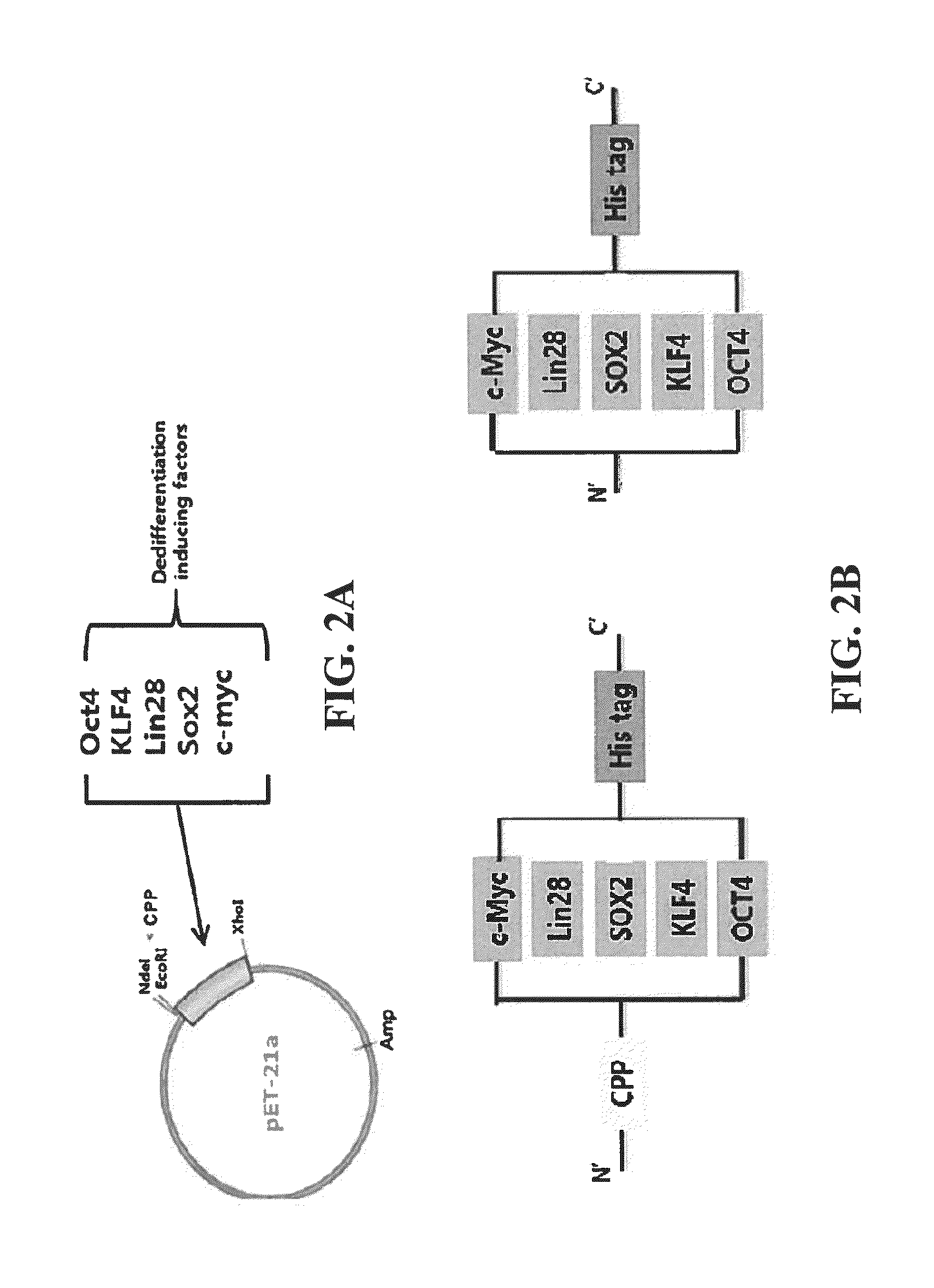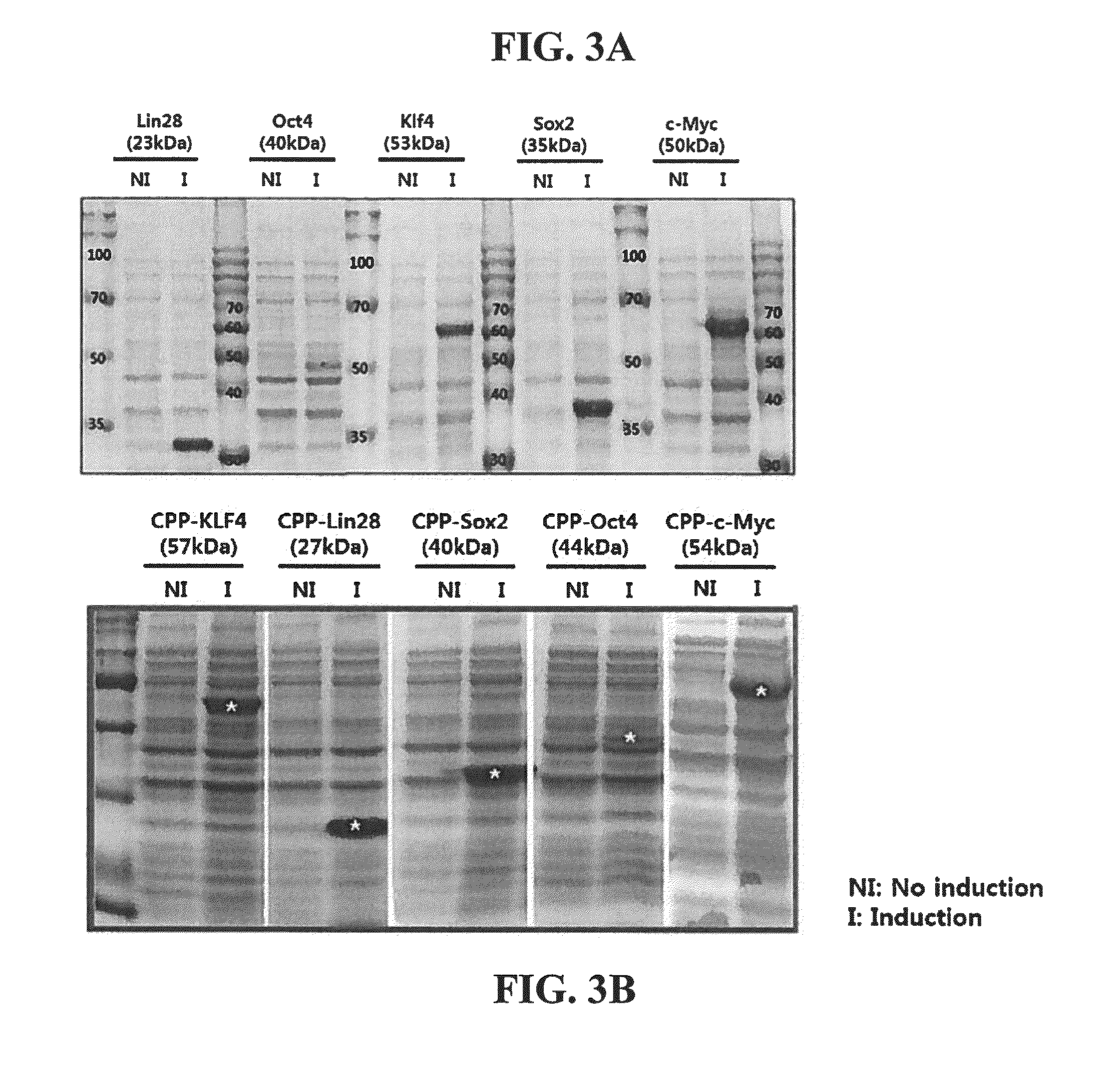Cell permeable fusion protein for facilitating reprogramming induction and use thereof
a fusion protein and cell technology, applied in the field of reprogramming induced pluripotent stem cells, can solve the problems of stability problem, limitation in the development of cellular therapeutic agents, insufficient technology of differentiation into desired cells, etc., and achieve high stability, maximize effect, and high efficiency
- Summary
- Abstract
- Description
- Claims
- Application Information
AI Technical Summary
Benefits of technology
Problems solved by technology
Method used
Image
Examples
example 2
Purification of Recombinant LMWP-Reprogramming Inducing Factor Fusion Protein
[0054]In order to increase a purification yield of the fusion protein prepared in Example 1, Example 2 was conducted under denature conditions in which three dimensional structure of the protein was denatured, and 8M urea was put into buffers (Lysis buffer, Washing buffer and Elution buffer) used for purification. The transformed E. coli BL21 was put into an LB medium containing ampicillin, and cultured with stirring at a rate of 180 rpm and a temperature of 37° C. When the bacterial concentration in the culture medium, OD600 value, was 0.3, IPTG was put into the medium so as to have a concentration of 1 mM. Then, after culturing for 4 hours, over-expression of the protein was induced. After the cultured cells were centrifuged and collected, 10 ml of lysis buffer (50 mM NaH2PO4, 300 mM NaCl, 10 mM imidazole, 8M urea, pH 8.0) and lysozyme from chicken egg white (Sigma-Aldrich, USA) 10 mg, complete EDTA-free ...
example 3
Measurement of In Vitro Cell Permeability of LMWP-Reprogramming Inducing Factor Fusion Protein
3-1: Measurement of Cell Permeability of LMWP-Reprogramming Inducing Factor Fusion Protein by Western Blotting Method
[0055]In order to confirm the cell permeability of the LMWP-reprogramming inducing factor fusion protein combined with DNA in cellular nucleus and functioned as a transcription factor, the cytoplasm and the nucleus of the fusion protein were separated from each other and confirmed by the Western blotting method. Each 1×106 of fibroblast groups containing the human dental pulp-derived stem cell were divided into 10 cm dish, and incubated overnight in a general medium for stabilizing the cell, for 20 hours. After the incubating overnight for 20 hours, the LMWP-reprogramming inducing factor and the control fusion protein in a concentration of 4 μg / ml were treated for 1 hour and 30 minutes.
[0056]Then, in order to compare states in which protein in cell was permeated, the cells tr...
example 4
Induction of Reprogramming Stem Cell Using LMWP-Reprogramming Inducing Factor Fusion Protein
4-1: Establishment of Reprogramming Stem Cell Utilizing LMWP-Reprogramming Inducing Factor Fusion Protein Under Direct Co-Culture with a Feeder Cell
[0059]A mouse embryonic fibroblast treated with mitomycin C was cultured in 6-well plate coated with 0.2% gelatin for 24 hours, in DMEM medium containing 10% FBS. The next day, the primarily cultured human dental pulp-derived mesenchyma stem cell in a concentration of 5×104 for each well was put thereinto and cultured for three more days. Then, the culture medium was changed every day with 20% Knock-out Serum Replacement, 1% Non-Essential Amino Acid, 100 ng / mL basic FGF or mTeSR™1, in the embryonic stem cell culture medium DMEM / F12. The reprogramming inducing medium contained five LMWP-reprogramming inducing factor fusion proteins in each concentration of 8 μg / ml with 20% Knock-out Serum Replacement, 1% Non-Essential Amino Acid, 100 ng / mL basic FG...
PUM
| Property | Measurement | Unit |
|---|---|---|
| pH | aaaaa | aaaaa |
| pH | aaaaa | aaaaa |
| temperature | aaaaa | aaaaa |
Abstract
Description
Claims
Application Information
 Login to View More
Login to View More - R&D
- Intellectual Property
- Life Sciences
- Materials
- Tech Scout
- Unparalleled Data Quality
- Higher Quality Content
- 60% Fewer Hallucinations
Browse by: Latest US Patents, China's latest patents, Technical Efficacy Thesaurus, Application Domain, Technology Topic, Popular Technical Reports.
© 2025 PatSnap. All rights reserved.Legal|Privacy policy|Modern Slavery Act Transparency Statement|Sitemap|About US| Contact US: help@patsnap.com



